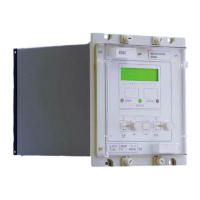VCG202/EN M/H11
Technical
4.9.1.3 Tap changer failure detection
The Tap Changer Failure feature is provided to detect failure of a tap changer to respond
to Raise/Lower commands of the relay.
Tap changer failure is detected by checking if the regulated voltage fails to come within
the deadband limits within the tFAIL time delay in response to a valid raise/lower
command. If a tap change failure is detected the TapFail output relay allocated in the
Relay Mask picks up to give an alarm indication and the flags which indicate that a tap
change is expected are reset. If the logic link [LOG1] is set to ‘1’ and the relay is in ‘Auto’
mode, the alarm condition will also cause blocking of the tap change control operation.
There is no direct inhibition of the alarm indication except by non selection in the output
mask.
The tap fail delay timer is reset instantaneously when the voltage is restored to within the
deadband limits.
4.10 Load shedding/boosting
The effective regulated voltage level (Vs) can be lowered or raised by means of the load
shedding/boosting option. This allows a system operator to override the VRR automatic
regulation to increase or decrease the system voltage supply. Adjusting the system
voltage will have a direct effect on the load current, decreasing the voltage will
reduce/shed load current and increasing the voltage will increase/boost the load current.
Three programmable levels are available settable between 0 to ±10% Vs and can be
selected either via K-Bus or by using external contacts to select one of 3 opto inputs
assigned to ‘Level 1’, ‘Level 2’ and ‘Level 3’ as required by the user. The stage of the
load shedding/boosting can be viewed under the SYSTEM DATA heading of the menu.
When link [SD2] is set to ‘1’, it enables load shedding / boosting in response to
commands over the serial port. When [SD2] is set to ‘0’, it prevents load shedding /
boosting in response to such commands over the serial port. The opto inputs will
override the commands over the serial port.
When the auxiliary supply to the relay is interrupted the states of the load shedding are
remembered. This ensures that the level of load shedding is not changed by
interruptions of the auxiliary supply.

